Summary: in this tutorial, you will learn how to use the Oracle RANK() function to calculate the rank of rows within a set of rows.
Introduction to Oracle RANK() function
The RANK() function is an analytic function that calculates the rank of a value in a set of values.
The RANK() function returns the same rank for the rows with the same values. It adds the number of tied rows to the tied rank to calculate the next rank. Therefore, the ranks may not be consecutive numbers.
The RANK() function is useful for top-N and bottom-N queries.
The following illustrates the syntax of the RANK() function:
RANK()
OVER ([ query_partition_clause ] order_by_clause)Code language: SQL (Structured Query Language) (sql)The order_by_clause is required. It species the order of rows in each partition to which the RANK() function applies.
The query partition clause, if available, divides the rows into partitions to which the RANK() function applies. If the query_partition_clause is omitted, the whole result set is treated as a single partition.
Oracle RANK() function examples
First, create a new table named rank_demo that consists of one column:
CREATE TABLE rank_demo (
col VARCHAR(10) NOT NULL
);Code language: SQL (Structured Query Language) (sql)Second, insert some rows into the rank_demo table:
INSERT ALL
INTO rank_demo(col) VALUES('A')
INTO rank_demo(col) VALUES('A')
INTO rank_demo(col) VALUES('B')
INTO rank_demo(col) VALUES('C')
INTO rank_demo(col) VALUES('C')
INTO rank_demo(col) VALUES('C')
INTO rank_demo(col) VALUES('D')
SELECT 1 FROM dual;
Code language: SQL (Structured Query Language) (sql)Third, get data from the rank_demo table:
SELECT col FROM rank_demo;Code language: SQL (Structured Query Language) (sql)Fourth, use the RANK() function to calculate the rank for each row of the rank_demo table:
SELECT
col,
RANK() OVER (ORDER BY col) my_rank
FROM
rank_demo;
Code language: SQL (Structured Query Language) (sql)The following shows the output:
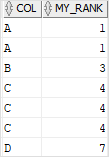
The first two rows received the same rank 1. The third row got the rank 3 because the second row already received the rank 1. The next three rows received the same rank 4 and the last row got the rank 7.
Oracle RANK() function examples
We’ll use the products table from the sample database for demonstration.
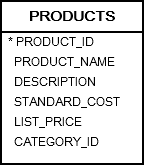
Oracle RANK() function simple example
The following statement calculates the rank of each product by its list price:
SELECT
product_name,
list_price,
RANK() OVER(ORDER BY list_price DESC)
FROM
products;
Code language: SQL (Structured Query Language) (sql)Here is the partial output:
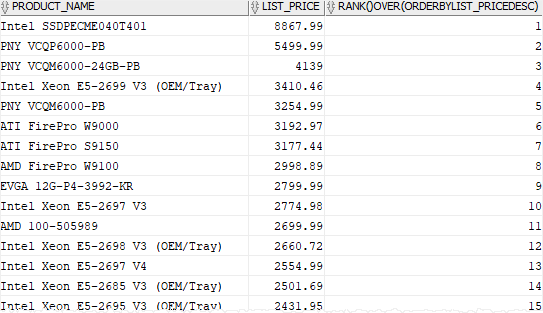
To get the top 10 most expensive products, you use the following statement:
WITH cte_products AS (
SELECT
product_name,
list_price,
RANK() OVER(ORDER BY list_price DESC) price_rank
FROM
products
)
SELECT
product_name,
list_price,
price_rank
FROM
cte_products
WHERE
price_rank <= 10;
Code language: SQL (Structured Query Language) (sql)In this example, the common table expression returned products with their ranks, and the outer query selected only the first 10 most expensive products.
Here is the output:
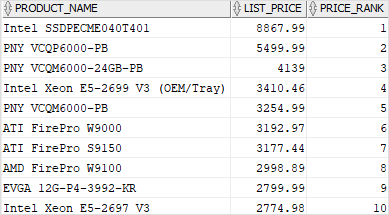
Using Oracle RANK() function with PARTITION BY example
The following example returns the top-3 most expensive products for each category:
WITH cte_products AS (
SELECT
product_name,
list_price,
category_id,
RANK() OVER(
PARTITION BY category_id
ORDER BY list_price DESC)
price_rank
FROM
products
)
SELECT
product_name,
list_price,
category_id,
price_rank
FROM
cte_products
WHERE
price_rank <= 3;
Code language: SQL (Structured Query Language) (sql)In this example:
- First, the
PARTITION BYclause divided the products into multiple partitions by category. - Then, the
ORDER BYclause sorted the rows in each partition by list price in descending order. - Finally, the
RANK()function calculated the rank for each row in each partition. It re-initialized the rank for each partition.
The following shows the output:
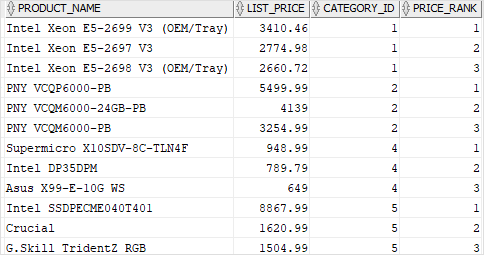
In this tutorial, you have learned how to calculate the rank of a value in a set of values by using the Oracle RANK() function.